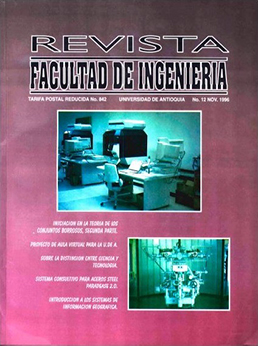Iniciación en la Teoría de los Conjuntos Borrosos (Segunda parte)
DOI:
https://doi.org/10.17533/udea.redin.325614Abstract
Este artículo es la continuación de otro publicado en el número anterior de esta revista. Su objetivo es establecer algunas generalizaciones respecto a lo escrito anteriormente y de fin ir otras operaciones y conceptos. Se continúa con la enumeración de títulos, ecuaciones y ejemplos, que se traía en el anterior artículo, correspondiendo iniciar acá con el numeral 4.Downloads
References
KAUFMANN, A. Introduction to the Theory of Fuzzy Subsets. Vol. I. New York, Academic Press, Inc., 1975. pp. 1-87, 167-172.
MOLINA, J.F. Teoría de Subconjuntos Borrosos y Sistemas Expertos. Revista Universidad EAFIT, Medellín, No. 76, pp. 27-40, octubre-diciembre , 1989 .
VIRGIL, N. Expert Systems and Fuzzy Systems. Menlo Park, California, The Benjamin/Cummings Company, Inc., 1985. pp.1-116,165-168.
KANDEL, A. Fuzzy Mathematical Techniques With Applications. Addison-Wesley Publishing Company. 274 p.
PRADE, H. & DUBOIS D. Fuzzy Sets and Systems. Academic Press, Inc. San Diego. 1980. 393 p.
Downloads
Published
How to Cite
Issue
Section
License
Revista Facultad de Ingeniería, Universidad de Antioquia is licensed under the Creative Commons Attribution BY-NC-SA 4.0 license. https://creativecommons.org/licenses/by-nc-sa/4.0/deed.en
You are free to:
Share — copy and redistribute the material in any medium or format
Adapt — remix, transform, and build upon the material
Under the following terms:
Attribution — You must give appropriate credit, provide a link to the license, and indicate if changes were made. You may do so in any reasonable manner, but not in any way that suggests the licensor endorses you or your use.
NonCommercial — You may not use the material for commercial purposes.
ShareAlike — If you remix, transform, or build upon the material, you must distribute your contributions under the same license as the original.
The material published in the journal can be distributed, copied and exhibited by third parties if the respective credits are given to the journal. No commercial benefit can be obtained and derivative works must be under the same license terms as the original work.










 Twitter
Twitter